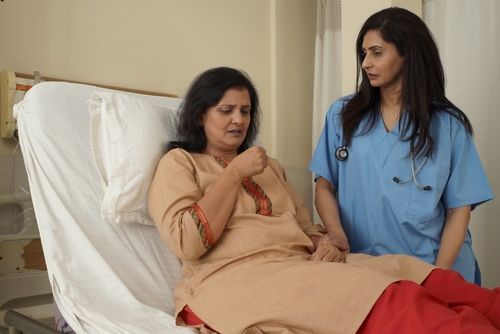
Multimorbidity, a co-occurrence of two or more conditions, is becoming a pressing issue globally. Approximately 30% of adults residing in developed countries encounter this issue (Jarde et al, 2023). Moreover, its ever-increasing prevalence in low and middle income countries (LMICs) is also raising concerns worldwide (Bush & Gorman, 2018).
The surge is attributed to various factors including the increased burden of chronic communicable diseases (CCDs) such as tuberculosis (TB) and HIV as well as demographic shifts, urbanisation, environmental changes, economic empowerment, and lifestyle alterations for non-communicable diseases (NCDs) (Cohen-Adad & Wheeler-Kingshott, 2014). The transition from childhood risks for CCDs to adulthood risks for NCDs is also reaching 34% in low income countries while 82% in middle income countries by 2019 (Goldman & Cooney, 2023). As the leading infectious illness in the world, tuberculosis (TB) accounts for 2.54% of all years of life lost and 1.86% of all disability-adjusted life years (DALYs) (Eyal et al., 2020).
TB and NCDs such diabetes mellitus, depression, and cancer frequently coexist (Stubbs et al., 2021). TB multimorbidity is defined as the simultaneous occurrence of TB and one or more chronic conditions (NCDs or CCDs) (Edlin et al., 2015). In addition to making the management a challenge, this co-occurrence has a negative impact on mortality, economic situation and health. The economical impact of TB multimorbidity additionally strains the already overburdened healthcare systems in low and middle income countries. Hence raising a high concern over meeting the healthcare costs and accessibility, making it difficult to meet global public health targets.
Existing systematic reviews have primarily focused on individual chronic conditions in individuals with TB (Huddart et al., 2020) (Gautam et al., 2021), but comprehensive evidence for various other chronic conditions, their prevalence and the associated burden in people with TB is lacking.
Alexander Jarde and colleagues (2023) reviewed the prevalence and risk of chronic diseases in individuals with tuberculosis (TB) in low and middle-income countries (LMICs), comparing them to those without TB. The review explores health outcomes in TB multimorbidity versus TB alone, addressing disease burden and the effectiveness of TB treatment.

People with tuberculosis are frequently affected by other health problems at the same time.
Methods
The review protocol was registered in advance in PROSPERO (CRD42020209012). A comprehensive search was conducted in relevant bibliographic databases, citation indexes and the WHO Global Index Medicus up to October 23, 2020. The reviewers also looked for unpublished studies, grey literature and conference abstracts.
The systematic review focused on people in low- and middle-income countries with any type of tuberculosis (TB) and one or more additional chronic conditions, including depression and anxiety disorders. Studies on children or specific groups were excluded.
Primary outcomes were the prevalence or incidence of chronic conditions in people with TB, along with odds ratios. Secondary outcomes included various measures of disease burden in TB multimorbidity.
The reviewers assessed the quality of the studies they included in their review. Blind, independent validation of included studies was also conducted and data extraction
Results
The review identified 54 studies covering 6,296,000 individuals with TB across in 85 low- and middle-income countries. Among them, 23 reviews offered a combined estimate, while others reported individual study outcomes, some including data from high-income countries. Despite examining similar combinations of TB and chronic conditions, these reviews exhibited limited overlap in geography and reported outcomes.
Characteristics of participants
The systematic reviews primarily focused on unspecified types of TB, with additional emphasis on drug-resistant TB (DR-TB), multidrug-resistant TB (MDR-TB), and extensively drug-resistant TB (XDR-TB) in 9 reviews. Three reviews centered on pulmonary TB (PTB), 3 on TB meningitis, and 1 on TB lymphadenitis. Among the chronic conditions, HIV was a key focus in 31 reviews, diabetes mellitus (DM) in 14 reviews, and mental illness in 5 reviews. Notably, none of the reviews explored the prevalence or associated risks of more than one additional chronic condition in people with TB.
Quality assessments using AMSTAR2 revealed that a significant majority of the identified systematic reviews were of low or critically low quality (42 reviews). Only seven reviews achieved moderate (n=2) or high (n=5) quality ratings, with six of them presenting a combined estimate of interest. The challenging domains often included risk of bias assessment (37 studies) and protocol registration (29 studies).
Multimorbidity in people with TB living in LMICs
The key reliable findings from this review (i.e. those taken from reviews rated as high quality) were:
- HIV is common in people with TB living in Sub-Saharan Africa
- Depression is common in people with TB living in low- and middle-income countries
- Depression is common in both men and women living with TB, affecting around half the people with TB
Results shown in bold in the table below are from reviews that were rated as high quality.
| Outcome | TB Population and setting | Result | CI | Studies | N |
HIV |
|||||
| Prevalence | Latin America | 25% | 19.3 to 30.8% | 7 | |
| Prevalence | Africa | 31.2% | 19.3 to 43.2% | 17 | |
| Prevalence | Western Sub-Saharan Africa | 25% | 1 | ||
| Prevalence | Southern Sub-Saharan Africa | 44% | 1 | ||
| Treatment success | Sub-Saharan Africa | OR = 0.87 | 0.79 to 0.96 | 6 | |
Diabetes |
|||||
| Prevalence | Lower income | 7.9% | 4.9 to 11.5% | 15 | 9,434 |
| Prevalence | Lower middle income | 17.7% | 15.1 to 20.5% | 48 | 48,036 |
| Prevalence | Upper middle income | 14.4% | 12.8 to 16.0% | 75 | 1,994,027 |
| Prevalence | Africa | 8.0% | 5.9 to 10.4% | 119 | 474,944 |
| Sub-Saharan Africa | 9% | ||||
| South Asia | 21% | ||||
| Mortality | OR = 1.8 | 1.35 to 2.40 | 34 | ||
| Treatment failure or death | OR = 1.9 | 1.43 to 2.53 | 22 | ||
Mental health |
|||||
| Treatment failure loss to follow-up or nonadherence | NS | ||||
| Depression | Lower middle income countries | 45.19% | 38 to 56% | 25 | 4,903 |
| Mortality | OR = 2.85 | 1.52 to 5.36 | 2 | 1,303 | |
| Anxiety | MDR-TB, South-East Asia and the Americas | 24% | 2 to 57% | 2 | 209 |
| Psychosis | MDR-TB, Africa | 12% | 8 to 17% | 5 | 7,518 |
| HCV | Africa | 11% | 1 to 23% | 3 | 327 |
| Lung cancer | Upper middle income | RR = 1.53 | 1.25 to 1.87 | 9 | |
| Non-Hodgkin’s | RR = 1.70 | 1.12 to 2.56 | 1 | ||
| Leukaemia | RR = 1.61 | 1.13 to 2.29 | |||
| CHD | Lower middle income | RR = 1.76 | 1.05 to 2.95 | ||
| HIV | Women in China | 0.6% | 0.3 to 1.1% | 9 | |
| HIV | Men in China | 1.1% | 0.6 to 2.0% | 9 | |
| Depression | Women | 51.54% | 40.3 to 62.6% | 17 | |
| Depression | Men | 45.25% | 35.2 to 55.7% | 17 |

This review suggests that in LMICs, almost half of people with tuberculosis also have depression.
Conclusion
High prevalence of tuberculosis (TB) multimorbidity demands immediate attention. In LMICs, where multimorbidity poses significant challenges, urgent research is needed to identify at-risk populations, prevent TB multimorbidity, and establish effective treatments and care pathways, considering the triple challenge of high multimorbidity rates, elevated TB levels, and strained healthcare systems. Urgent efforts are required to navigate the complexities associated with TB multimorbidity in LMICs and develop strategies to alleviate its impact.
Strengths and limitations
Key strengths of this review include a comprehensive search strategy involving grey literature and protocols, ensuring thorough coverage. Emphasising low- and middle-income countries (LMICs) and excluding data from high-income countries enhances the applicability of results to LMIC contexts. The focus on PROSPERO registration and author outreach further strengthens the robustness of the search strategy.
Limitations of this review include high heterogeneity in meta-analyses, cautioning interpretation. Methodological differences in defining comorbidities and variations in TB treatment strategies within countries contribute to this heterogeneity. Over half of the summarised studies had low or critically low quality. Despite the extensive systematic reviews, the LMICs focus excluded relevant results, and we found limited evidence on the burden of TB multimorbidity, revealing gaps in systematic review evidence and prompting future research directions.

There was high heterogeneity in this meta-analysis, so we should interpret these findings with caution.
Implications
This review has significant implications for practice, policy, and research, demanding a shift in how we approach and manage tuberculosis (TB) patients.
Implications for practice
Screening for the high prevalence of co-morbidities like HIV, diabetes, and mental health issues in TB patients is needed for managing them holistically with coordinated treatment plans. Also modifying TB treatment based on co-morbidities is crucial; this could help in improving treatment adherence.
Training of healthcare workers is essential for managing multimorbidity, particularly the specific challenges associated with TB and its common co-occurring conditions. This includes understanding drug interactions, side effects, and best practices for integrated care.
Implications for policy
LMICs need strong healthcare systems with sufficient resources for diagnosis, treatment, and follow-up of both TB and other chronic conditions. Implicating social policy measures to tackle root causes such as poverty, malnutrition, and restricted healthcare access, which are significant contributors to both tuberculosis and multimorbidity, is crucial for enhancing general health outcomes.
Implications for research
Moreover, further research is needed to identify early at-risk populations and to understand the complex interplay between TB and co-morbidities and their treatment outcome to develop effective interventions, and optimise integrated care models. Policymakers should prioritise funding for conducting clinical research in these areas. Demonstrating improved patient outcomes and cost savings will strengthen the case for policy implementation.

Training of healthcare workers is essential for managing multimorbidity, particularly the specific challenges associated with TB and its common co-occurring conditions.
Statement of interest
A group of 7 people co-authored this blog: Aliya Ayub, Asima Niazi, Nida Afsheen, Tooba Seemi, and Badur un Nisa. This work was done as part of a blogging workshop run by The Mental Elf for the Centre for IMPACT – a NIHR Global Health Research Centre established to improve mental and physical health together: https://www.impactsouthasia.com/
Links
Primary paper
, et al (2023) Prevalence and risks of tuberculosis multimorbidity in low-income and middle-income countries: a meta-review.
Other references
- Bush, N. J., & Gorman, L. M. (2018). Psychosocial Nursing Care Along the Cancer Continuum. https://books.google.com/books/about/Psychosocial_Nursing_Care_Along_the_Canc.html?hl=&id=l3NWswEACAAJ
- Cohen-Adad, J., & Wheeler-Kingshott, C. (2014). Quantitative MRI of the Spinal Cord. Academic Press. https://books.google.com/books/about/Quantitative_MRI_of_the_Spinal_Cord.html?hl=&id=VjBnAgAAQBAJ
- Edlin, R., McCabe, C., Hulme, C., Hall, P., & Wright, J. (2015). Cost Effectiveness Modelling for Health Technology Assessment: A Practical Course. https://books.google.com/books/about/Cost_Effectiveness_Modelling_for_Health.html?hl=&id=vA5cCgAAQBAJ
- Eyal, N., Hurst, S. A., Murray, C. J. L., Wikler, D., & Andrew Schroeder, S. (2020). Measuring the Global Burden of Disease: Philosophical Dimensions. Oxford University Press, USA. https://books.google.com/books/about/Measuring_the_Global_Burden_of_Disease.html?hl=&id=TnXnDwAAQBAJ
- Gautam, S., Shrestha, N., Mahato, S., Nguyen, T. P. A., Mishra, S. R., & Berg-Beckhoff, G. (2021). Diabetes among tuberculosis patients and its impact on tuberculosis treatment in South Asia: a systematic review and meta-analysis. Scientific Reports, 11(1), 2113. https://doi.org/1038/s41598-021-81057-2
- Goldman, L., & Cooney, K. A. (2023). Goldman-Cecil Medicine E-Book. Elsevier Health Sciences. https://books.google.com/books/about/Goldman_Cecil_Medicine_E_Book.html?hl=&id=ieLLEAAAQBAJ
- Huddart, S., Svadzian, A., Nafade, V., Satyanarayana, S., & Pai, M. (2020). Tuberculosis case fatality in India: a systematic review and meta-analysis. BMJ Global Health, 5(1), e002080. https://doi.org/1136/bmjgh-2019-002080
- (PDF) Prevalence and risks of tuberculosis multimorbidity .. (n.d.). https://www.researchgate.net/publication/363891320_Prevalence_and_risks_of_tuberculosis_multimorbidity_in_lowand_middle-income_countries_a_meta-review
- Stubbs, B., Siddiqi, K., Elsey, H., Siddiqi, N., Ma, R., Romano, E., Siddiqi, S., & Koyanagi, A. (2021). Tuberculosis and Non-Communicable Disease Multimorbidity: An Analysis of the World Health Survey in 48 Low- and Middle-Income Countries. International Journal of Environmental Research and Public Health, 18(5). https://doi.org/3390/ijerph18052439
